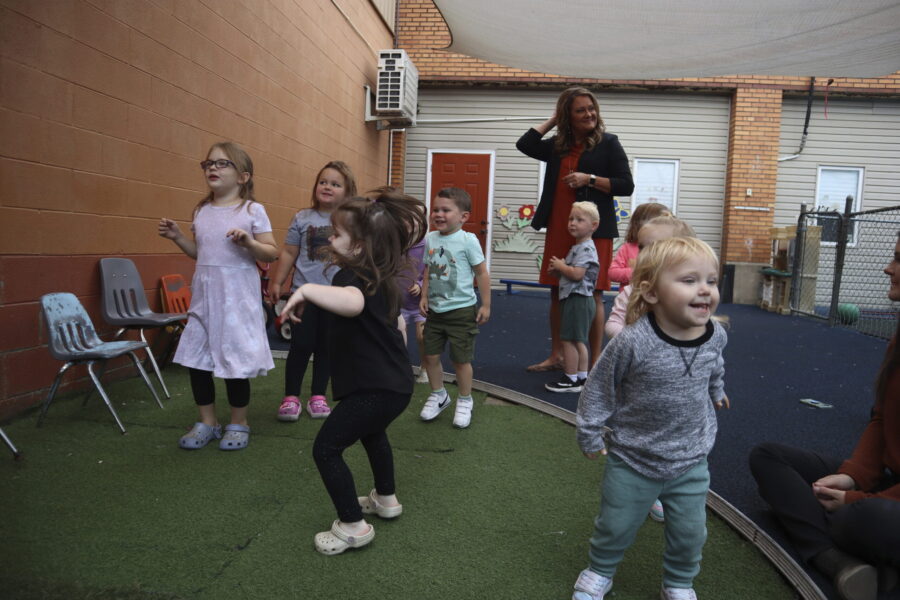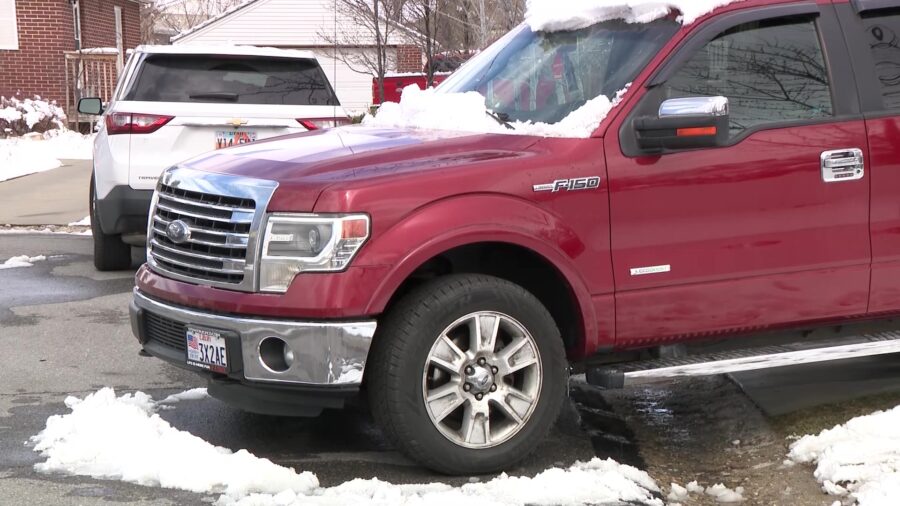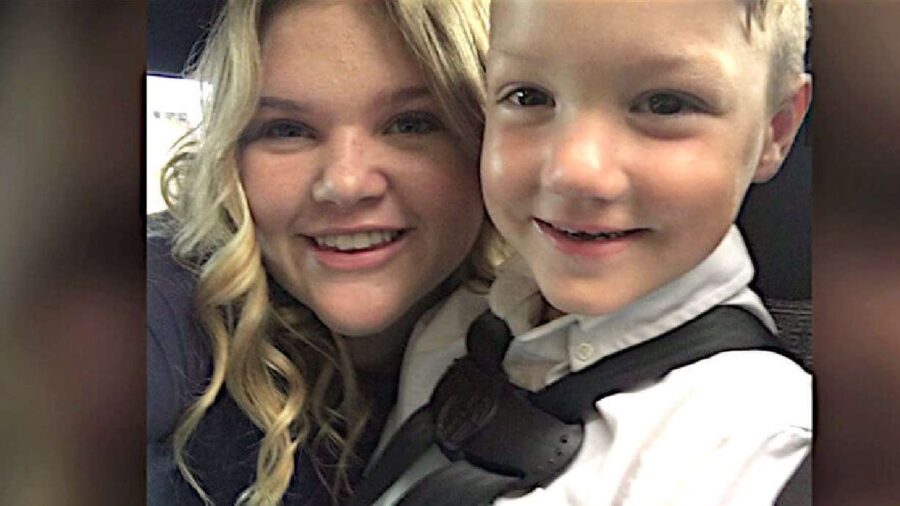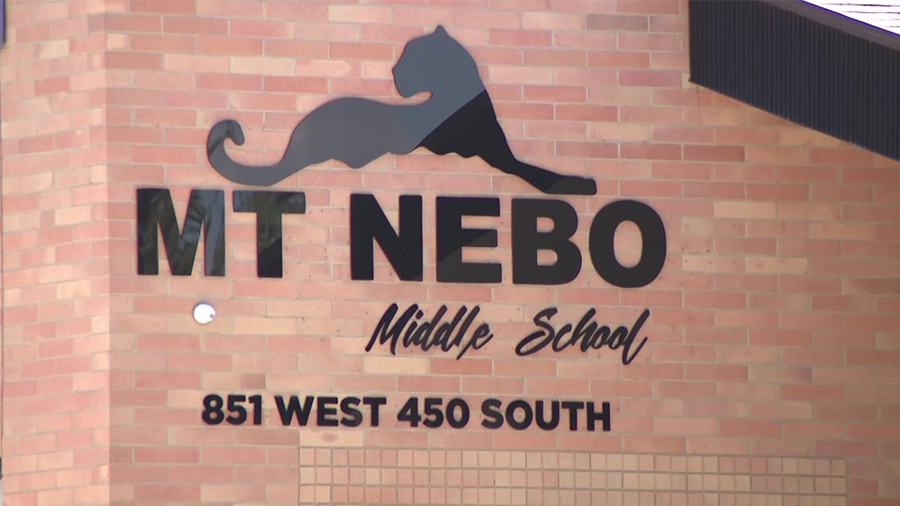Child care programs just lost thousands of federal dollars. Families, providers scramble to cope
Oct 3, 2023, 10:18 PM | Updated: Oct 4, 2023, 12:41 am

Toddlers dance during play time at Living Water Child Care and Learning Center as center director Jackie Branch looks on in Williamson, W.Va. on Monday, Sept. 25, 2023. (AP Photo/Leah Willingham)
(AP Photo/Leah Willingham)
WILLIAMSON, W.Va. (AP) — Kaitlyn Adkins is studying law to help families in her community impacted by the opioid epidemic at the heart of West Virginia coal country.
But to do that, she needs someone to help look after her three toddlers. The first-generation college graduate said she wouldn’t be able to finish law school without access to reliable daycare.
Providers say millions of children and their families are now at risk of losing that vital service. After two years of receiving federal subsidies, 220,000 child care programs across the country were cut off from funding Saturday. The largest investment in child care in U.S. history, the monthly payments ranged from hundreds to tens of thousands of dollars, and stabilized the industry during the COVID-19 pandemic.
“It feels like they’re just setting everyone up for failure,” Adkins said, dropping her 2-year-old and 1-year-old twins at daycare on a recent morning before an hour-and-a-half drive to class.
For years, providers have been raising alarm about an unsustainable business model that burdens families with high costs and leaves centers with razor-thin profit margins — issues only exacerbated by inflation and a significant workforce shortage.
Now, providers say that without additional investment, they face the possibility of shutdown. The Century Foundation, a progressive think tank in Washington, D.C., analyzed a provider survey and government data, and concluded that in six states — Arkansas, Montana, Utah, Virginia, West Virginia, as well as Washington, D.C. — up to half of all providers may be forced to close.
Many families and providers are calling on Congress to create a permanent funding solution to the crisis, warning of the ripple effects on the nation’s economy. A Democratic proposal failed last month without any Republican support. It would have continued the grants for five years with $16 billion allocated annually.
The most at-risk providers are those in rural communities that predominately serve low-income families. In West Virginia, where a quarter of all children live in poverty, the situation is especially dire.
Adkins brings her children to a center affiliated with a church in Williamson, West Virginia, where nearly 90% of families qualify for federal aid to help cover child care costs. For a family of four, that means making less than $45,000 a year. Williamson is the seat of Mingo County, where one in three residents live below the poverty line, and more than 75% of children in the county school system are being raised by someone other than their parents, often grandparents.
Most mornings, Adkins wakes up at 5:30 a.m. to shuttle her kids to Living Water Child Care Center. She typically gets home late, and plays with and bathes her children before studying until early morning.
The proud daughter of a former coal miner, Adkins said she’s witnessed the loss of coal jobs and the influx of opioids in the state with the highest rate of overdoses. She said taxpayers will end up paying more in the long run to welfare programs if the government doesn’t make investments now in child care.
“We’re seeing our kids really suffer — and that’s a big problem,” said Adkins, who wants to practice law focused on child abuse and neglect. “If they have no structure and no guidance, we’re going to keep repeating cycles.”
Starting in October 2021, Democrats’ American Rescue Plan Act disbursed $24 billion in payments to providers across the country, with varied funding based on program size and quality rating. In West Virginia, centers received an average $5,000 to $27,000 a month and family providers got between $750 to $3,200. The legislation also included $15 billion to expand the block grant program that subsidizes the cost of child care for low-income families, though it is set to expire in September 2024.
At Living Water, a $7,000 monthly subsidy went to purchasing new curriculum and advancing employee certifications, according to Director Jackie Branch. The investment paid off: In April, the center moved up a tier in its state quality rating, increasing its monthly stabilization funding to $11,000.
When staffers realized many children didn’t get outside playtime at home, they installed a rubber playground and colorful sunshades.
School-aged kids can finally work on homework assignments in the after-school program thanks to recently purchased computers.
Like most providers in the state, Living Water was also able to offer staff bonuses.
As of May 2022, the median pay for a child care worker in the U.S. was $13.71, compared with $10.47 in West Virginia, according to the U.S. Bureau of Labor. Wage growth in the industry has fallen behind other low-wage professions.
Over the years, Goldie Huff, a waitress at a steakhouse in Williamson, has cared for more than two dozen foster care children. There are just two child care centers in the entire county, and the community can’t afford to lose either one, she said.
“It would be horrible,” she said, if Living Waters closed. All of her foster children have attended Living Water, along with kids, grandchildren and other family members. The state has the highest number of youth in foster care in the country.
She said a lot of the kids she cares for are recovering from traumatic childhood experiences and need structure. “How many kids do you know that don’t wake up to breakfast? They don’t know where the meals are coming from. They’ve not had baths. They’ve never had nice clothes.”
The center serves three meals a day, plus snacks. They also distribute donations such as clothes and school supplies.
Branch said it will be an uphill battle to find other grants to make up for lost funds.
Policymakers should not only be worried about shuttering centers, but also about the quality of care and education available with such limited resources, said Melissa Colagrosso, CEO of A Place To Grow Children’s Center, in Fayetteville, West Virginia. Since they opened 28 years ago, the number of accredited centers in the state has been halved.
“Right in the beginning, that’s our opportunity to really change the brain and change a child’s future,” she said. “You invest in early childhood, then you invest less in prisons.”
West Virginia’s Department of Health and Human Resources announced last week it was sending providers a final bonus payment as September drew to a close, but that funds were tapped. The agency also allocated $24 million in TANF funds to reimburse providers for children whose costs are subsidized based on enrollment rather than attendance for another year.
But providers say what they need instead is a permanent, long-term funding solution.
If West Virginia wants to grow its economy, child care is part the infrastructure necessary for that to happen, Tiffany Gale said. She isn’t a parent herself, but just months before the pandemic started, she began caring for six children at her home in West Virginia’s northern panhandle.
In just three years, she’s moved up a level in the state’s quality rating status and expanded into an empty commercial space downtown. She has five staff members and 18 children — 24 split between the two sites — who would have otherwise been waitlisted. Three-quarters of them are considered low-income, and qualify for government-subsidized care.
With the help of federal subsidies, Gale was able to purchase the two units next door. But now that the pandemic-era support is ending, Gale doesn’t know if she’ll be able to stay in business.
Policymakers have relied on the passion of child care providers — who are mostly women — to find a way to make ends meet without the resources and support they really need, Gale said.
“They’re still going to do it, whether they’re living in poverty and having to go to the food bank every week or not,” she said, of child care workers’ commitment to work. “I think we really take advantage of that instead of lifting them up, lifting children up and lifting our communities up.”













